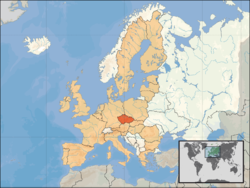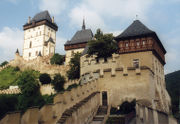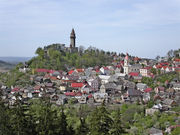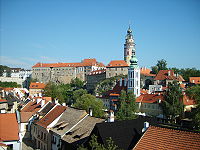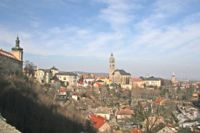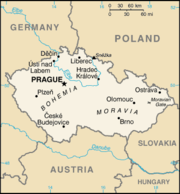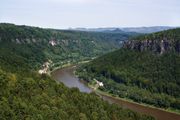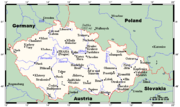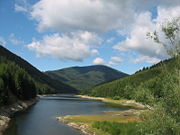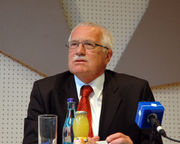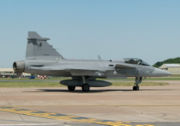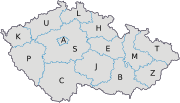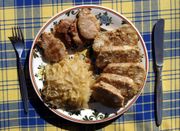Czech Republic
2008/9 Schools Wikipedia Selection. Related subjects: Europe; European Countries
| Česká republika Czech Republic
|
||||||
|---|---|---|---|---|---|---|
|
||||||
| Motto: "Pravda vítězí" ( Czech) "Truth prevails" |
||||||
| Anthem: Kde domov můj? (in English: Where is My Home?) |
||||||
|
Location of the Czech Republic (orange)
– on the European continent (camel & white) |
||||||
| Capital (and largest city) |
Prague |
|||||
| Official languages | Czech | |||||
| Demonym | Czech | |||||
| Government | Parliamentary republic | |||||
| - | President | Václav Klaus | ||||
| - | Prime Minister | Mirek Topolánek | ||||
| Independence | (formed 9th century) | |||||
| - | from Austria-Hungary | October 28, 1918 | ||||
| - | Czechoslovakia dissolved | January 1, 1993 | ||||
| EU accession | May 1, 2004 | |||||
| Area | ||||||
| - | Total | 78,866 km² ( 117th) 30,450 sq mi |
||||
| - | Water (%) | 2 | ||||
| Population | ||||||
| - | 20081 estimate | 10,403,136 ( 78th) | ||||
| - | 2001 census | 10,230,060 | ||||
| - | Density | 132/km² ( 77th) 341/sq mi |
||||
| GDP ( PPP) | 2007 IMF estimate | |||||
| - | Total | $248.902 billion ( 39th²) | ||||
| - | Per capita | $24,236 ( 36th) | ||||
| GDP (nominal) | 2007 IMF estimate | |||||
| - | Total | $175.309 billion ( 39th) | ||||
| - | Per capita | $17,070 ( 36th) | ||||
| Gini (1996) | 25.4 (low) ( 5th) | |||||
| HDI (2005) | ▲ 0.891 (high) ( 32nd) | |||||
| Currency | Czech koruna ( CZK) |
|||||
| Time zone | CET ( UTC+1) | |||||
| - | Summer ( DST) | CEST ( UTC+2) | ||||
| Internet TLD | .cz³ | |||||
| Calling code | +4204 | |||||
| 1 | March 31, 2008 (See Population changes - 1st quarter of 2008). | |||||
| 2 | Rank based on 2005 IMF data. | |||||
| 3 | Also .eu, shared with other European Union member states. | |||||
| 4 | Shared code 42 with Slovakia until 1997. | |||||
The Czech Republic (IPA: /ˈtʃɛk riˈpʌblɨk/) ( Czech: Česká republika ( help· info), short form in Czech: Česko, IPA: [ʧɛsko]), is a landlocked country in Central Europe and a member state of the European Union. The country has borders with Poland to the northeast, Germany to the west, Austria to the south, and Slovakia to the east. The capital and largest city is Prague ( Czech: Praha), a major tourist destination. The country is composed of the historic regions of Bohemia and Moravia, as well as parts of Silesia.
Following the Battle of the White Mountain, the Czech lands fell under the Habsburg rule from 1526, later becoming part of the Austrian Empire and Austria-Hungary. The independent Republic of Czechoslovakia was formed in 1918, following the collapse of the Austro-Hungarian empire after World War I. After the Munich Agreement, German occupation of Czechoslovakia and the consequent disillusion with the Western response and gratitude for the liberation of the major portion of Czechoslovakia by the Red Army, the Communist party won plurality (38 %) in 1946 elections. In an 1948 overturn, Czechoslovakia became a communist-ruled state. In 1968, the increasing dissatisfaction has culminated in attempts to reform the communist regime. The events, known as Prague Spring of 1968, had ended with a invasion of armies of Warsaw Pact countries, and the troops remained in the country until the overturn in 1989 Velvet Revolution, when the communist regime collapsed. On January 1, 1993 the country Czechoslovakia peacefully split into the Czech Republic and Slovakia.
The Czech Republic made economic reforms such as massive privatization and flat tax. Annual gross domestic product growth has recently been around 6%. The country is the first former member of the Comecon to achieve the status of a developed country (2006) according to the World Bank. The Czech Republic also ranks best compared to the former Comecon countries in the Human Development Index.
The Czech Republic is a pluralist multi-party parliamentary representative democracy. President Václav Klaus is the current head of state. The Prime Minister is the head of government (currently Mirek Topolánek). The Parliament has two chambers — the Chamber of Deputies and the Senate. The Czech Republic joined NATO in 1999 and the European Union in 2004. It is also a member of the OECD, the Council of Europe and the Visegrád Group.
Name
After the dissolution of Czechoslovakia, the Czech portion found itself without a common single-word name in English. In 1993, The Czech Ministry of Foreign Affairs suggested the name Czechia as an official alternative in all situations other than formal official documents and the full names of government institutions; however, this has not become widely used--though other languages have single-word names, e.g. Tschechien in German, and Czechy in Polish. The official website of the Czech Republic ( www.czech.cz) run by the Czech Ministry of Foreign Affairs does not use the name Czechia as of 2005. Its Czech equivalent is Česko.
History
Archaeologists have found evidence of prehistoric human settlement in the area dating back to the Neolithic era. In the classical era, from the 3rd century BC Celtic migrations, the Boii (see Bohemia) and later in the 1st century Germanic tribes of Marcomanni and Quadi settled there. During the Migration Period around the 5th century, many Germanic tribes moved westwards and southwards out of Central Europe. In an equally significant migration, Slavic people from the Black Sea and Carpathian regions settled in the area (a movement that was also stimulated by the onslaught of peoples from Siberia and Eastern Europe: Huns, Avars, Bulgars and Magyars). Following in the Germans' wake, they moved southwards into Bohemia, Moravia, and some of present day Austria. During the 7th century the Frankish merchant Samo, supporting the Slavs fighting their Avar rulers, became the ruler of the first known Slav state in Central Europe. The Moravian principality arose in the 8th century (see Great Moravia). The Bohemian or Czech state emerged in the late 9th century when it was unified by the Přemyslid dynasty. The kingdom of Bohemia was a significant regional power during the Middle Ages. It was part of the Holy Roman Empire during the entire existence of this confederation.
Religious conflicts such as the 15th century Hussite Wars and the 17th century Thirty Years' War had a devastating effect on the local population. From the 16th century, Bohemia came increasingly under Habsburg control as the Habsburgs became first the elected and then hereditary rulers of Bohemia. After the fall of the Holy Roman Empire, Bohemia became part of Austrian Empire and later of Austria-Hungary.
From Czechoslovakia to World War 2
Following the collapse of the Austro-Hungarian Empire after World War I, the independent republic of Czechoslovakia was created in 1918. This new country incorporated regions of Bohemia, Moravia, Silesia, Slovakia and Carpathian Ruthenia (known as Subcarpathian Rus at the time) with significant German, Hungarian, Polish and Ruthenian speaking minorities. Although Czechoslovakia was a unitary state, it provided what was at the time rather extensive rights to its minorities. However, it did not grant its minorities any territorial political autonomy, which resulted in discontent and strong support among some of the minorities to break away from Czechoslovakia. Adolf Hitler used the opportunity and, supported by Konrad Henlein's Sudeten German National Socialist Party, gained the largely German speaking Sudetenland through the 1938 Munich Agreement. Poland occupied Polish inhabited areas around Český Těšín. Hungary gained parts of Slovakia and Subcarpathian Rus as a result of the First Vienna Award in November 1938.
Slovakia and Subcarpathian Rus gained greater autonomy, with the state renamed to "Czecho-Slovakia" (The Second Republic; see Occupation of Czechoslovakia). Slovakia seceded in March 1939 and allied itself with Hitler's coalition. The remaining Czech territory was occupied by Germany, transformed it into the so-called Protectorate of Bohemia and Moravia. The Protectorate was proclaimed part of the Third Reich, and President and Prime Minister were subordinate to the Nazi Reichsprotektor ("imperial protector"). Subcarpathian Rus declared independence as the Republic of Carpatho-Ukraine on 15 March 1939 but was invaded by Hungary the same day and formally annexed on 16 March. Approximately 390,000 Czechoslovak citizens, including 83,000 Jews, were killed or executed, and hundreds of thousands of others were sent to prisons and concentration camps or as forced labour. A Nazi concentration camp existed at Terezin to the north of Prague. There was Czech resistance to Nazi occupation both home and abroad, most notably with the assassination of leading Nazi leader Reinhard Heydrich in Prague suburbs on May 27, 1942. The Czechoslovak government-in-exile and its army fighting against the Germans were acknowledged by Allies (Czechoslovak troops fought in Great Britain, North Africa, Middle East and Soviet Union). The occupation ended on 9 May 1945 with the arrival of Soviet and American armies and the Prague uprising.
In 1945-46 almost the entire German minority of Czechoslovakia, about 2.7 million people, were expelled to Germany and Austria. During this time, thousands of Germans were held in prisons, detention camps, and used as forced labour. In the summer of 1945, there were several massacres. Only 250,000 Germans who had been active in the resistance against the Nazis or were necessary for the economy were not expelled, though many of them emigrated later. Following a Soviet-organised referendum, the Subcarpathian Rus has never returned under Czechoslovak rule and became part of the Ukrainian SSR, as the Zakarpattia Oblast in 1946.
Communist era
Czechoslovakia uneasily tried to play the role of a "bridge" between the West and East. However, the Communist Party of Czechoslovakia rapidly increased in popularity, particularly because of a general disappointment with the West (due to the pre-war Munich Agreement) and a favourable popular attitude towards the Soviet Union (due to the Soviets' role in liberating Czechoslovakia from German rule). In the 1946 elections, with 38% of the votes, the Communists became the largest party in the Czechoslovak parliament. They formed a coalition government with other parties of the National Front, and moved quickly to consolidate power. The decisive step took place in February 1948. During a series of events characterized by Communists as a "revolution" and by anti-Communists as a "takeover", the Communist People's Militias secured control of key locations in Prague, and a new, all-Communist government was formed.
For the next forty-one years, Czechoslovakia was a Communist state within the eastern bloc (see Czechoslovakia: 1948-1989). This period was marked by a variety of social developments. The Communist government completely nationalized the means of production and established a command economy. The economy grew rapidly during the 1950s and 1960s, but slowed down in the 1970s with increasing problems during the 1980s. The political climate was highly repressive during the 1950s (including numerous show trials), but became more open and tolerant in the 1960s, culminating in Alexander Dubček's leadership in the 1968 Prague Spring that tried to create "socialism with a human face" and perhaps even introduce political pluralism. This was forcibly ended by 21 August 1968 Warsaw Pact invasion. From then until 1989, the political establishment returned to censorship of opposition, though using more "carrot" than "whip" policy to ensure the populace's passivity.
Czech Republic
In November 1989, Czechoslovakia returned to democracy through a peaceful " Velvet Revolution". However, Slovak national aspirations strengthened until on January 1, 1993, the country peacefully split into the independent Czech Republic and Slovakia. Both countries went through economic reforms and privatisations, with the intention of creating a market economy.
From 1991 the Czech Republic (originally as part of Czechoslovakia, and now in its own right) has been a member of the Visegrad Group and from 1995 of the OECD. The Czech Republic joined NATO on March 12, 1999 and the European Union on May 1, 2004.
Geography
The Czech landscape is quite varied. Bohemia to the west consists of a basin, drained by the Elbe ( Czech: Labe) and the Vltava rivers, and surrounded by mostly low mountains such as the Krkonoše range of the Sudetes. The highest point in the country, Sněžka, at 1,602 m (5,262 ft), is located here. Moravia, the eastern part of the country, is also quite hilly. It is drained mainly by the Morava River, but it also contains the source of the Oder ( Czech: Odra) River. Water from the landlocked Czech Republic flows to three different seas: the North Sea, Baltic Sea and Black Sea. The Czech Republic also leases the Moldauhafen, a 30,000- square-metre (7.4- acre) lot in the middle of the Hamburg Docks, which was awarded to Czechoslovakia by Article 363 of the Treaty of Versailles to allow the landlocked country a place where goods transported downriver could be transferred to seagoing ships. The territory reverts to Germany in 2028.
Phytogeographically, the Czech Republic belongs to the Central European province of the Circumboreal Region within the Boreal Kingdom. According to the WWF, the territory of the Czech Republic can be subdivided into four ecoregions: the Central European mixed forests, Pannonian mixed forests, Western European broadleaf forests and Carpathian montane conifer forests.
Weather and climate
The Czech Republic has a temperate, continental climate with relatively hot summers and cold, cloudy winters, usually with snow. Most rains are during the summer. The temperature difference between summers and winters is relatively high due to its landlocked geographical position.
Even within the Czech Republic, temperatures vary greatly depending on the elevation. In general, at higher altitudes the temperatures decrease and precipitation increases. Another important factor is the distribution of the mountains. Therefore the climate is quite varied.
At the highest peak ( Sněžka, 1,602 m/5,260 ft) the average temperature is only −0.4 °C (31 °F), whereas in the lowlands of South Moravia, the average temperature is as high as 10 °C (50 °F). This also applies for the country's capital Prague, but this is due to urban factors.
The coldest month is usually January followed by February and December. During these months there is usually snow in the mountains and sometimes in the major cities and lowlands. During March, April and May, the temperature usually increases rapidly and especially during April the temperature and weather tends to vary widely during the day. Spring is also characterized by high water levels in the rivers due to melting snow followed by floods at times.
The warmest month of the year is July, followed by August and June. On average, the summer temperatures are about 20 °C (68 °F) higher than during winter. Especially in the last decade, temperatures above 30 °C (86 °F) are not unusual. Summer is also characterized by rain and storms.
Autumn generally begins in September, which is still relatively warm, but much drier. During October, temperatures usually fall back under 15° or 10°C (59° or 50°F) and deciduous trees begin to shed their leaves. By the end of November, temperatures usually range around the freezing point.
Demographics
Population
| Year | Total | Change | Year | Total | Change |
|---|---|---|---|---|---|
| 1857 | 7,016,531 | — | 1930 | 10,674,386 | 6.6% |
| 1869 | 7,617,230 | 8.6% | 1950 | 8,896,133 | -16.7% |
| 1880 | 8,222,013 | 7.9% | 1961 | 9,571,531 | 7.6% |
| 1890 | 8,665,421 | 5.4% | 1970 | 9,807,697 | 2.5% |
| 1900 | 9,372,214 | 8.2% | 1980 | 10,291,927 | 4.9% |
| 1910 | 10,078,637 | 7.5% | 1991 | 10,302,215 | 0.1% |
| 1921 | 10,009,587 | -0.7% | 2001 | 10,230,060 | -0.7% |
The vast majority of the inhabitants of the Czech Republic are Czechs (94.2%). Minorities include the Slovaks (1.9%), Poles (0.5%), Vietnamese (0.44%) Germans (0.4%). According to the Interior Ministry of the Czech Republic, there were 392,087 foreigners legally residing in the country at the end of 2007, making up 3.2% of the population, with the largest groups being Ukrainians and Slovaks.
Fertility rate was low at 1.44 children born/woman. In 2007, immigration added to the population by almost 1%.
Religion
The Czech Republic, along with Estonia, has one of the least religious populations in all of Europe. According to the 2001 census, 59% of the country is agnostic, atheist, non-believer or no-organised believer, 26.8% Roman Catholic and 2.5% Protestant.
According to the most recent Eurobarometer Poll 2005, 19% of Czech citizens responded that "they believe there is a God", whereas 50% answered that "they believe there is some sort of spirit or life force" and 30% that "they do not believe there is any sort of spirit, God, or life force", the lowest rate of EU countries after Estonia with 16%.
Politics
Political system
The Czech Republic is a pluralist multi-party parliamentary representative democracy, where the Prime Minister is the head of government. The Parliament is bicameral, with the Chamber of Deputies ( Czech: Poslanecká sněmovna) (200 members) and the Senate (81 members).
Foreign policy
A key goal in foreign policy has been European integration.
According to The Economist, the Czech Republic has earned a reputation for promoting human rights at every turn. Czech officials have pushed Europe's weight behind democrats everywhere from Myanmar to Belarus, Moldova and Cuba. The Czech foreign ministry has an entire unit devoted to helping dissidents in other countries.
Czech Republic is motivated by its experience of Nazi and communist oppression. Also, the country's first post-communist president Václav Havel is an ex-dissident writer, who has set moral example and has attracted ex-dissidents to key government positions. For example, every March since 2003, when Fidel Castro locked up 75 political opponents, activists have set up a cage in Wenceslas Square representing a Cuban prison cell. Frequent prison uniform-wearing protesters have included names such as the foreign minister, the mayor of Prague and musical stars. Some EU officials have been irritated by Czech Republic's activism in human rights. Czech Republic and other countries stressing human rights have been in conflicts with EU countries who favour closer ties with dictatorships.
Armed forces
The Czech armed forces consist of the Army and Air Force and of specialized support units. In 2004, the Czech armed forces completely phased out conscription and transformed into a fully professional army and air force. The country has been a member of NATO since March 12, 1999. Defence spending is around 1.8% of GDP (2006).
Regions and districts
Since 2000, the Czech Republic is divided into thirteen regions ( Czech: kraje, singular kraj) and the capital city of Prague. Each region has its own elected Regional Assembly (krajské zastupitelstvo) and hejtman (usually translated as hetman or "president"). In Prague, their powers are executed by the city council and the mayor.
The older seventy-six districts (okresy, singular okres) including three 'statutory cities' (without Prague, which had special status) were disbanded in 1999 in an administrative reform; they remain as territorial division and seats of various branches of state administration.
| ( Lic. plate) | Region | Capital | Population (2004 est.) | Population (2008 est.) |
|---|---|---|---|---|
| A | Capital of Prague (Hlavní město Praha) | 1,170,571 | 1,218,644 | |
| S | Central Bohemian Region (Středočeský kraj) | offices located in Prague (Praha) | 1,144,071 | 1,208,145 |
| C | South Bohemian Region (Jihočeský kraj) | České Budějovice | 625,712 | 633,750 |
| P | Plzeň Region (Plzeňský kraj) | Pilsen (Plzeň) | 549,618 | 562,783 |
| K | Karlovy Vary Region (Karlovarský kraj) | Karlovy Vary | 304,588 | 307,975 |
| U | Ústí nad Labem Region (Ústecký kraj) | Ústí nad Labem | 822,133 | 833,218 |
| L | Liberec Region (Liberecký kraj) | Liberec | 427,563 | 434,751 |
| H | Hradec Králové Region (Královéhradecký kraj) | Hradec Králové | 547,296 | 552,850 |
| E | Pardubice Region (Pardubický kraj) | Pardubice | 505,285 | 512,380 |
| M | Olomouc Region (Olomoucký kraj) | Olomouc | 635,126 | 641,809 |
| T | Moravian-Silesian Region (Moravskoslezský kraj) | Ostrava | 1,257,554 | 1,249,844 |
| B | South Moravian Region (Jihomoravský kraj) | Brno | 1,123,201 | 1,142,013 |
| Z | Zlín Region (Zlínský kraj) | Zlín | 590,706 | 590,828 |
| J | Vysočina Region (Vysočina) | Jihlava | 517,153 | 514,146 |
Economy
The Czech Republic possesses a developed, high-income economy with a GDP per capita of 82% of the European Union average. One of the most stable and prosperous of the post-Communist states, the Czech Republic has seen a growth of over 6% annually in the last three years. Recent growth has been led by exports to the European Union, especially Germany, and foreign investment, while domestic demand is reviving. However, the rate of corruption remains one of the highest among OECD countries.
The public budgets remain in deficit despite strong growth of the economy in recent years. However, the 2007 deficit has been 1.58% GDP (according to EU accounting rules), far less than originally expected.
Most of the economy has been privatized, including banks and telecommunications. The current right-centre government plans to continue with privatization, including the energy industry and the Prague airport. It has recently agreed to the sale of a 7% stake of the energy producer ČEZ, with the sale of the Budějovický Budvar brewery also mooted.
The country has fully implemented the Schengen Agreement and therefore has abolished border controls with all of its neighbours (Germany, Austria, Poland, Slovakia) on December 21, 2007. The Czech Republic is a member of the WTO.
The last Czech government had expressed a desire to adopt the euro in 2010, but the current government has postponed it due to budget deficits. An exact date has not been set up, but the Finance Ministry described adoption by 2012 as realistic if public finance reform passes. However, the most recent draft of the euro adoption plan omits giving any date.
Education
The Programme for International Student Assessment, coordinated by the OECD, currently ranks the Czech education as the 15th best in the world, being higher than the OECD average.
Transport
Prague Airport is the main international airport. Czech Republic has 46 airports, out of which two have over 3,047 meter runaways.
Energy
In 2005, according to the Czech Statistical Office, 65.4% of electricity was produced in steam, combined, and combustion power plants (mostly coal); 30% in nuclear plants; and 4.6% from renewable sources, including hydropower. Russia (via pipelines through Ukraine) and, to a lesser extent, Norway (via pipelines through Germany) supply the Czech Republic with liquid and natural gas.
Communications
The Czech Republic has the most Wi-Fi subscribers in the European Union. By the beginning of 2008 there was over 800 mostly local WISPs with about 350 000 subscribers in 2007. Mobile internet is quite popular. Plans based on either GPRS, EDGE, UMTS or CDMA2000 are being offered by all three mobile phone operators ( T-Mobile, Vodafone, Telefonica O2) and U:fon. Government-owned Český Telecom slowed down broadband penetration. At the beginning of 2004, local loop unbundling began, and alternative operators started to offer ADSL (and also SDSL). This, and later privatisation of Český Telecom helped drive down prices. On July 1, 2006, Český Telecom was renamed to Telefónica O2 Czech Republic. As of January 2006, ADSL2+ is offered in many variants, both with data limit and without with speeds up to 10 Mbit/s. Cable internet is gaining popularity with its higher download speeds beginning at 2 Mbit/s up to 20 Mbit/s. The biggest ISP, UPC (which has bought another CATV internet provider Karneval in 2007) is providing its service in big cities (Prague, Brno, Ostrava)
Tourism
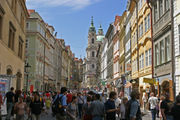
The Czech economy gets a substantial income from tourism: in 2001, the total earnings from tourism reached 118.13 billion CZK, making up 5.5% of GNP and 9.3% of overall export earnings. The industry employs more than 110,000 people - over 1% of the population.
There are several centres of tourist activity: The historic city of Prague is the primary tourist attraction, and the city is also the most common point of entry for tourists visiting other parts of the country. Most other cities in the country attract significant numbers of tourists, but the spa towns such as Karlovy Vary, Mariánské Lázně and Františkovy Lázně are particularly popular holiday destinations. Other popular tourist sites are the many castles and chateaux, such as those at Karlštejn, Konopiště and Český Krumlov. Away from the towns, areas as Český ráj, Šumava and the Krkonoše Mountains attract visitors seeking outdoor pursuits.
The country is also famous for its love of puppetry and marionettes. The Pilsner style beer originated in western Bohemian city of Plzeň.
Culture
Cuisine
Czech cuisine is marked by a strong emphasis on meat dishes. Pork is quite common, and beef and chicken are also popular. In the last years with the incoming immigrants, Kebab is a popular food of Czech Cuisine as well. Goose, duck, rabbit and wild game are served. Fish is rare, with the occasional exception of fresh trout, and carp, which is served at Christmas.
Aside from Slivovitz, Czech beer and wine, Czechs also produce two uniquely Czech liquors, Fernet Stock and Becherovka. Kofola is a non-alcoholic Czech soft drink somewhat similar in look and taste to Coca-Cola.
Sport
Sport plays a significant part in the life of many Czechs who are generally loyal supporters of their favourite teams or individuals. The two leading sports in the Czech Republic are football and ice hockey, both drawing the largest attention of both the media and supporters. The many other sports with professional leagues and structures include basketball, volleyball, handball, athletics, floorball and others. Sport is a source of strong waves of patriotism, usually rising several days or weeks before an event and sinking several days after. The events considered the most important by Czech fans are: the Ice Hockey World Championship, Olympic Ice hockey tournament, the Euro, the football World Cup and qualification matches for such events. In general, any international match of the Czech ice hockey or football national team draws attention, especially when played against a traditional rival: Germany in football; Russia, Sweden and Canada in ice hockey; and Slovakia in both.
Music
Music in the Czech Republic has roots both in high-culture opera and symphony and in the traditional music of Bohemia and Moravia. Cross-pollination and diversity are important aspects of Czech music: Composers were often influenced by traditional music; jazz and bluegrass music have become popular; pop music often consisted of English language hits sung in Czech.
Literature
Czech literature is the literature of the historical regions of Bohemia, Moravia, and the Czech-speaking part of Silesia, (now part of the Czech Republic, formerly of Czechoslovakia). This most often means literature written by Czechs, in the Czech language, although Old Church Slavonic, Latin, and German were also used, mostly in the early periods. Modern authors from the Czech territory who wrote in other languages (e.g. German) are generally considered separately, and their writing usually existed in parallel with Czech-language literature and did not interact with it. Thus Franz Kafka, for example, who wrote in German (though he also knew Czech rather well), falls within Austrian literature, though he lived his entire life in Bohemia.
Czech literature is divided into several main time periods: the Middle Ages; the Hussite period; the years of re-Catholicization and the baroque; the Enlightenment and Czech reawakening in the 19th century; the avantgarde of the interwar period; the years under Communism and the Prague Spring; and the literature of the post-Communist Czech Republic. Czech literature and culture played a major role on at least two occasions when Czech society lived under oppression and no political activity was possible. On both of these occasions, in the early 19th century and then again in the 1960s, the Czechs used their cultural and literary effort to create political freedom and to establish a confident, politically aware nation.
International rankings
- Human Development Index 2007: Rank 32nd out of 178 countries
- Index of Economic Freedom 2007: Rank 31st out of 157 countries
- Reporters Without Borders world-wide press freedom index 2007: Rank 14th out of 169 countries
- Global Competitiveness Report 2006: Rank 29th out of 125 countries
- Democracy Index (January 2007): Ranks 18th of 167 countries (a functioning democracy along with only 27 others)
- It was also ranked as the highest alcohol-consuming nation by The Economist in 2006.


